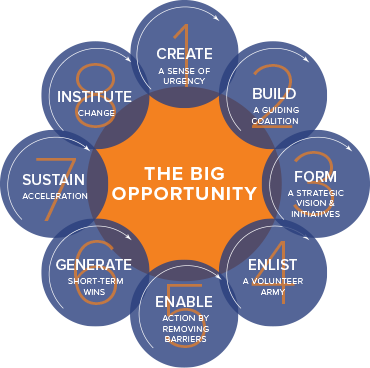The answer my friends is blowin’ in the wind …
BOB DYLAN (1962): BLOWIN’ IN THE WIND
Managing is about getting things done through and with people. The textbooks tell us that managers carry out four integrated functions: planning, organizing, leading, and controlling. They apply these four functions to managing four business functions: marketing, operations, finance, and people. Managers aim to optimize the performance and results of their organization.
Change is a process through which something becomes or is made different, whether strategy, structure, function, technology, culture, attitude, or capacity. It is situational, contextual, and focused on outcomes. It can be holistic or incremental. Change is an ever-present condition that challenges organizations to manage for best results.
But transitions, not changes, do in managers. Transition is psychological and starts with an ending. It is the process that people follow to internalize, grasp, and communicate the details of the new situation that change embeds. According to William Bridges, managing transitions has three phases:
- Letting Go – ending the old ways and allowing people time to grieve their loss;
- The Neutral Zone – realigning mindsets and patterns in-between the old and the new; and
- The New Beginning – launching a new identity, energy, and purpose.
People resist change. Changes of any sort ultimately succeed when the people affected do things differently. Einstein is quoted as saying, “Insanity is doing the same thing over and over again and expecting different results.” Implementing change is like solving a problem: (1) identify the need for change; (2) define and diagnose the problem; and (3) formulate and implement a solution.
Public managers model purpose, direction, and stewardship when they manage time, talent, resources, and responsibilities in the public interest. Foresight, innovation, and adaptability are the Holy Trinity of management competencies required in an era of non-stop, unpredictable change. Middle managers are strategic change makers at the forefront of managing change.
Dr. John Kotter’s process for leading change is legendary in the annals of change management. It claims to equip Fortune 500 companies with the means to transform themselves quickly, continuously, and with powerful results. Organizations that do not evolve may not last unless they develop the mindset and skillset necessary to manage change.
Over four decades, Dr. Kotter observed countless leaders and organizations trying to execute transformative strategies. The critical success factors were combined in an eight-step methodology first published in 1996 in Leading Change. Kotter International released the new-improved, impactful Accelerate in 2014.
The world is moving faster and changing at an accelerated pace, while the capacity to keep up is not. The impetus for transformation remains more and better everything, everywhere, right now. Are organizations capable of managing change in today’s globalized, digitized environment? Are trust and relationship issues among leaders and workers obstacles to change?
We wonder whether people are:
- Disengaged – dispassionate about their roles, colleagues, managers, and customers;
- Falsely urgent – consumed by constant activity and firefighting;
- Complacent – lulled into thinking that what got them here will get them there;
- Lopsided – focused more on management than on leadership; and
- Siloed – known more for boundaries than for gateways.
Kotter’s enhanced 8-Step Process is designed to serve today’s context and objectives. It embraces four differences from older models:
- Runs the steps concurrently and continuously instead of responding to episodic change in finite and sequential ways;
- Forms a large volunteer corps from up, down, and across the organization instead of driving change with a small, powerful core group;
- Functions in a flexible, agile network instead of working only within the traditional hierarchy; and
- Capitalizes quickly and constantly on opportunities and initiatives instead of doing one thing at a time in a linear fashion.
To balance reliability and responsiveness, the traditional hierarchy and the innovation network must share clear communication and synchronicity. Knowing how to change and transform is critical.
This article begins a new series on change management. The series features a public sector spin on Kotter’s change model for middle managers.
John Wilkins is Executive in Residence: Public Management at York University. He was a career public servant and diplomat. (jwilkins@schulich.yorku.ca)

